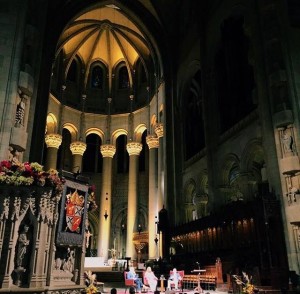by Howard Clemens
Begun in 2013, the Washington D.C. Capitol Renovation project is now winding down. With the final coats of paint being added now is an excellent time to learn about the nation’s Capitol building – and see it anew. The signature dome needs periodic renovation because it is made of iron, and there are places where moisture has rusted the dome and its embellishments. This leakage affects overall structure. Since the status of the exterior threatens the interior of the Capitol, time was of the essence in spearheading this project.
The exterior of the capitol building was last renovated in the 1960s. A study revealed over one thousand cracks in need of repair, many on the east end of the building. To expeditiously reverse the aging building’s decay the Architect of the Capitol, Stephen Ayers, stepped in with a plan for a thorough overhaul of this historic building. He adapted a “lock and stitch” technique to patch the aging iron structure and envisioned a thoroughly repaired and sealed Capitol Dome from start to finish.
Piece by piece, the Architect of the Capitol and crew have been stirring up lost histories about the U.S. Capitol. The building itself was more like a forum at one time, with a large rotunda and place for representatives to meet formally to debate bills. In the 1860s, Thomas Walter, an architect, won a contest for plans to add two wings to the Capitol: one for senate offices and one for the house of representatives’ offices. His idea for the dome was not included in his contest submission. Instead, his vision of an ancient Roman and European inspired dome was part of a large drawing on his office wall. Being in the unique position of architect, Walter was able to convince government officials to sign onto his vision. The dome was completed in 1863.
Blended Learning About the Capitol
Students may not be on site at the Capitol, but can learn much about what goes on there by visiting the Architect of the Capitol website (www.aoc.gov) and viewing YouTube footage of this historical project. Here, individual details of the Capitol and its builders are featured.
A lengthier piece on the history of the Capitol to present day is available in a clip from Sixty Minutes (https://www.youtube.com/watch?v=nu3DicMrzKY). Viewing this news story will help students put the history of the Capitol into perspective.
Students may be all too familiar with the sight of the scaffolding covering the Capitol building on the news. Through class exercises students can be asked to closely examine the history of the U.S. Capitol. Informed by research, students will become familiar with the people and stories behind the Capitol building.
The Statue of Freedom
Considering the unique history of the Capitol’s expansion, it should come as no surprise the Statue of Freedom atop its peak is also mired in a remarkable history. Made by Thomas Crawford, an art student in France in 1863, the Bronze statue is a true symbol of the melting pot of humanity – converging in the United States. Crawford cast freedom as a woman who appears to be dressed in Native American garb and also has an eagle’s feathers and open beak draping her crown, with the nine stars of liberty around he forehead. In her left hand, the statue grasps “the laurel wreath of victory and the shield of the United States with 13 stripes.” The charm of her exquisite natural beauty and native garb combined with the symbolism of the eagle and stars and stripes make the crowning sculpture on the U.S. Capitol a symbol of a diverse nation with pride.
Students can further explore the history of the artist, Thomas Crawford, and detailed features of the statue of liberty at: http://www.aoc.gov/capitol-hill/other-statues/statue-freedom.
Teachers will want to think about capping the in-classroom Web based learning and research by planning a real time class trip to Washington D.C. In D.C., student groups can see the inside of the Capitol Rotunda and tour the interior of the building to learn even more facts. Student groups will be able to observe the representative branch of government in action.
To learn more about scheduling a class trip to Washington D.C. Request a Quote.



